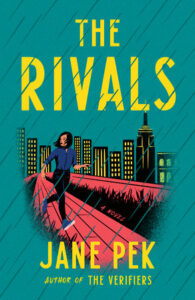Want to Write Better Fiction? Break Seven Ribs

In the spring of last year, I broke seven ribs in one go.
I was at my Krav Maga class—to add insult to literal injury, not doing anything remotely badass; we were in the middle of a warm-up drill that my partner and I got a tad too enthusiastic about.
Absent complications, there’s typically no treatment for fractured ribs. You wait, hope that your bones will grow back together the way the doctors say they’re supposed to, wait some more. In my case, with the sheer quantity that I had broken, and the fact that six of the seven fractures were displaced (i.e. the two edges of the break had shifted apart), I was like one of those new housing developments in New York that look just fine from the outside but are semi-uninhabitable due to shoddy construction.
I’d always figured that my preference for the past and the future is one of the reasons I’m drawn to writing fiction.
I’m a person who by nature tends to be either looking back on the past or looking ahead to the future. Sometimes, both: I get so caught up with anticipating what’s coming that I neglect the actual experience of the event, and then I’m left wishing I hadn’t done that and replaying my memories of what happened. For the several weeks after my injury, though, I found myself very much stuck in the present.
In part I was tethered there by the new limitations of my body. The simplest of actions, which I’d generally had the fortune to take for granted, suddenly ranged from arduous to impossible—lying down or sitting up, turning around, laughing or coughing or, god forbid, sneezing. I had to calibrate everything, from reaching for a mug in the cabinet to stepping off the sidewalk. Doctors had warned that a fall before I fully recovered could be catastrophic, which left me marginally paranoid about my surroundings. At all times I was hyper-aware that I was here and now, a resident in this apartment building of unsound structural integrity, monitoring for signs of shakiness, unable to leave.
Psychologically, as well, life came to feel much more immediate. For the first month, I left my home only for doctor’s appointments and a daily, snail’s-pace walk along the Hudson River which was essential for my sanity. Apart from the kindness of visiting friends, my calendar cleared out, since all my usual activities were barred from me: Krav Maga, long bike rides, bakery-hopping, sitting through two-hour-long plays. My world shrank to sourcing calcium-rich foods, getting as much rest as possible, and hoping that I wouldn’t wake up the next morning with a punctured lung.
Throughout this period, I continued to write, which is one thing you can do with multiple broken bones, even if the output may be dubious—and my own changed experience of time led me to think more deeply about the subject of time in fiction. It’s one of the fun things about being a fiction writer, having the superpower of manipulating the force that holds us at its mercy in our actual lives. You can slow time down, spending pages on a single moment, or speed it up, vaulting over months or years of your characters’ lives. You can hopscotch through chronology, moving between prior and subsequent events at your will.
I’d always figured that my preference for the past and the future is one of the reasons I’m drawn to writing fiction. Stories are driven by what characters want, which always enlists both the past and the future. A character’s past experiences shape who they are in the present time of the story, including what their desires are; and, barring Time’s Arrow-type conceits, those desires relate to how things will be in the future.
We can see this most clearly in novels like Persuasion or The Great Gatsby, where the reintroduction of the past into the present—Captain Wentworth showing up in Anne Elliot’s life seven years after she broke off their engagement; Jay Gatsby reviving an acquaintance with Daisy Buchanan five years after he was posted overseas in WWI and she went on to marry another man—propels the plot forward. Some novels tilt even more toward the past, with their narratives largely comprised of, or deriving their power from, events that occurred prior to the present time—think any number of elegaic English novels, from Brideshead Revisited (the title says it all) to The Go-Between to The Remains of the Day. Other novels choose to start from the beginning of the story which is being told, planting their stakes firmly in the future.
As a writer, the present felt to me like the shallowest of the three temporal eras. The past provides context for and significance to the characters’ present-day actions; and the potential consequences of those actions, i.e., the future, create relevance and urgency. In contrast, the present seemed to be mainly concerned with execution, moving the characters from point A to B to C.
During my convalescence, I did my own revisiting of how some of my favorite novels employ the present, and to what effect. How does an author decide on which point in their characters’ timeline to be the now of the story, and why? The obvious answer is when there is some meaningful change to the status quo that the story wants to explore the implications of. My old writing professor would say there are only two kinds of stories—a stranger comes to town and hero goes on a journey—and also that they are really the same story, told from two perspectives. Pride and Prejudice, which begins when Bingley arrives at Netherfield, is an example of the former; Middlemarch, which begins with Dorothea’s coming of age to be married, is an example of the latter.
Plenty of stories, though, opt for a present time well after this change in the status quo, and even after a resolution has been reached as a result of such change—like all those elegaic English novels, for instance; and also, I was intrigued to realize when I reread it, Breakfast at Tiffany’s. I hadn’t really appreciated before that the story opens well after Holly Golightly has left New York and the narrator has lost touch with her: “[T]here is a brownstone in the East Seventies where, during the early years of the war, I had my first New York apartment….It never occurred to me in those days to write about Holly Golightly, and probably it would not now except for a conversation I had with Joe Bell that set the whole memory of her in motion again.” After describing that conversation, the story moves back in time to when the narrator first met Holly and provides a portrait of this remarkable character as observed by the narrator during the period of their friendship.
A narrator can control the past and project the future, but the present must be lived in.
I’d previously viewed this set-up in fiction as using the present simply as the “excuse” for the narrator to recall past events. But it also enables the author to refract the telling of those events through the medium of time, providing an interpretation that is mediated by both knowledge (the narrator knows what happens after the events they are recounting) and change (the narrator now is a different person from who they were then). This results in a richer, more nuanced story—at the expense, I’d argue, of a certain degree of surprise and momentum.
This backward-looking structure does afford another kind of surprise, in stories that utilize the present for revelation as well as refraction: the narrator, examining the past in the light of the present, discovers something new about what they experienced. This can happen because the present-day narrator obtains information that transforms their understanding of the past—in The End of the Affair, for instance, Bendrix learns the real reason for, well, the end of his affair. Or it can be a subtler, internal sort of discovery, the narrator realizing as they are telling their story what they have missed until now, as with Stevens in The Remains of the Day, a contender for most emotionally repressed character ever.
As with Breakfast at Tiffany’s, in rereading The Remains of the Day I was able to appreciate an important aspect of that novel’s treatment of time. The present-day storyline is about Stevens driving across England to visit his ex-colleague Mrs. Benn (nee Kenton), the former housekeeper of the residence where Stevens still works as butler. The narrative builds toward their meeting, which takes on greater significance as we learn, through Stevens’s memories, about their relationship—and then skips right over it! The reader only finds out what happened two days later, when Stevens reflects on his conversation with Mrs. Benn, allowing himself, finally, to admit his regret at what might have been. Thus, even the most critical present-day event in the book is related as coming from the past; that’s the only way Stevens is able to share it with us, after he has safely sealed it away in time, something to be recollected and not experienced. Here the absence of the present speaks to its power. A narrator can control the past and project the future, but the present must be lived in.
It’s a reminder that applies not only in fiction but also in life As my ribs healed up, I found myself recurringly surprised and grateful for each movement that caused less pain than I had remembered, and then no pain at all. The day I managed a full-on sneeze was a celebratory one. I’ve tried to hold on to this new appreciation of all the things I previously never even noticed—at least, until the next injury.
__________________________________

The Rivals by Jane Pek is available from Vintage, an imprint of Knopf Doubleday Publishing Group, a division of Penguin Random House, LLC.